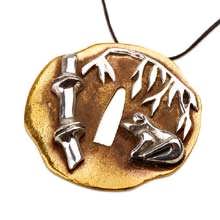
Basho's Tsuba
Poderoso símbolo del despertar y ver la realidad
Despierta a la luminosidad de la vida
The Tsuba is actually the hand shield from the Samurai swords. In the 17-18th century when there were periods of peace in Japan, the Tsuba, like the Samurai sword itself, became a decorational symbol used in various ceremonies. Skilled Artists and jewelers produced breathtaking models according to demand. The Tsuba reflected Japanese tradition and included traditional Japanese geometric models. The Tsubas included images from nature in accordance with Haiku poetry that describes a moment in time and traditional symbols that reflect courage, fidelity, diligence and clarity of thought.
The Tsubas from my point of view represent the symbol of “The Diamond sword” from Zen philosophy. The very sword that metaphorically cuts the world of illusion, the superfluous thoughts and feelings that mislead the human being and prevent him from seeing and accepting the reality as it is.
The Tsuba is a symbol of courage, fidelity and diligence.
The Basho Tsuba
This Tsuba is dedicated to Basho - one of the greatest Haiku poets. He wrote his first poem at the age of 18 after a Zen teacher asked him about his state of consciousness. Basho’s answer to the question was “When a frog jumps to an ancient pool the sound of water is heard.”
Haiku poetry and the pendant symbolize clarity of though. The poetry is made up of several small vowels and lines and describes the moment that the poet experienced in a completely lucid manner and in direct truth, without the metaphors and laden imagery and figures of the western poetry. Haiku poetry is so clean that it allows us to sense that very moment frozen in time that is hidden in the poem, even if it was written hundreds of years ago.
The pendant is made of silver and brass.